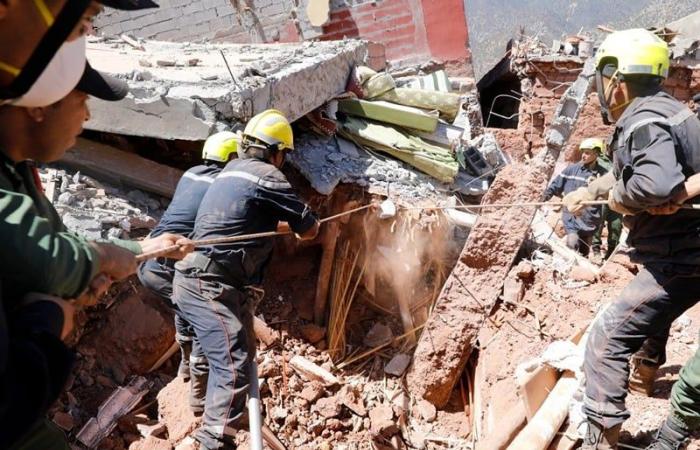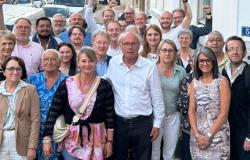The devastating Al Haouz earthquake caused considerable economic losses for Morocco, with a significant direct cost for the infrastructure of the affected provinces and a loss of GDP estimated at 0.24% for the year 2023. Faced with this situation, the Moroccan government has initiated an ambitious Reconstruction Program of 120 billion dirhams, intended to rebuild the disaster areas and stimulate economic activity in the High Atlas region. In a briefing from the Policy Center for the New South (PCNS), five analysts examine in detail the economic consequences of the earthquake and the expected impacts of reconstruction efforts.
The direct cost of the Al Haouz earthquake for the affected provinces represents the estimated expenditure on infrastructure needed to restore them to their pre-disaster levels. In this regard, economic infrastructure losses were concentrated around the earthquake epicenter in Al-Haouz, followed by neighboring provinces, mainly Taroudant and Chichaoua, the information note emphasizes.
Regarding the indirect cost of the earthquake, comparing the base case (an artificial counterfactual assuming the earthquake did not occur) with the actual occurrence (the earthquake actually occurred ), the results of the simulation, carried out to prepare this note, “indicate a loss of GDP of around 0.24%, equivalent to around 3 billion dirhams in 2023”.
As a result, economic activity in the Marrakech region fell by 1.3%, while Al-Haouz province lost around 10.2% of its GDP. The other provinces of Morocco recorded smaller losses, proportional to their respective links with the affected provinces.
Al-Haouz province recorded 53% of the total loss of gross regional product among the six most affected regions, for a total of around 1.2 billion dirhams. It is closely followed by the province of Taroudant with a loss of gross regional product of 739 million dirhams. The other affected provinces, Chichaoua, Marrakech, Ouarzazate and Azilal, collectively suffered a loss of gross regional product of around 305 million dirhams.
Impact of the “Program for the reconstruction and rehabilitation of affected areas”
The Moroccan authorities have launched a 5-year reconstruction program, with a budget of 120 billion dirhams. This budget will be divided into two main pillars: 22 billion dirhams for emergency aid to households and the reconstruction of infrastructure, and 98 billion dirhams for the upgrade of the High Atlas region.
The first pillar of this Program thus includes emergency aid to households and financial aid for housing for a total amount of 8 billion dirhams over the period 2023-2024, and 14 billion dirhams for reconstruction and upgrading. infrastructure from 2023 to 2028. “The results of the simulations for the first pillar indicate that the injection of 22 billion dirhams into the Moroccan economy will lead to an increase of 0.1 percentage points in overall growth at the country level and an increase of 1.2 percentage points in growth for the High Atlas provinces on average between 2024 and 2028.”it is explained in the note.
And to emphasize: “Moving from the national to the provincial level, the difference between the new growth trajectory and the baseline scenario (IMF growth projections before the disaster) increases significantly in terms of relative magnitude. This is mainly due to the fact that the most affected provinces – Al Haouz, Chichaoua and Taroudant – will receive the majority of the 22 billion dirhams of the recovery plan.”.
The second pillar concerns 98 billion dirhams intended to stimulate and promote economic activity throughout the High Atlas region. “In the absence of precise information on the allocation of these funds, we will consider three hypothetical scenarios. The first scenario assumes that the entire 98 billion dirhams will be financed by new resources, such as debt. The second scenario consists of distributing the 98 billion dirhams equally between new financing (50%) and the reallocation of existing investments (50%). The third scenario envisages financing entirely through the reallocation of existing investments”the note says.
National impact
Country-level growth simulations, which integrate the effects of both pillars of the Reconstruction Program, suggest that the overall impact varies significantly depending on the financing scenario. This ranges from an average of 0.4 percentage points for the “New Money” scenario to 0.03 percentage points for the “Reallocation” scenario over the period 2024-2028.
“The stark contrast between the two extreme scenarios – new money and complete reallocation of investments – is explained by the fact that the first represents a hypothetical scenario in which the government injects around 10% of GDP into the economy in the form of new funds. In contrast, the second scenario involves a simple reallocation of investment funds from unaffected to affected areas, which is expected to have only a modest positive impact on national growth,” the note reads.
Regional impact
For the High Atlas provinces, growth simulations incorporating the impacts of the two pillars systematically show positive effects on growth in all financing scenarios. This is because these provinces receive funding regardless of its source, resulting in minimal variations between different funding scenarios.






